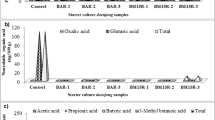Abstract
Gochujang, a savory and pungent fermented sauce, is a Korean ethnic food composed primarily of fermented soybean cake, red pepper powder, glutinous rice, and salt. Industrial gochujang is fermented following inoculation with Aspergillus oryzae and Bacillus subtilis as starter microorganisms. In contrast, a wide variety of natural fungi and bacteria are used in fermentation and aging of artisanal gochujang, the aging period of which is longer than 6 months. We monitored ochratoxin A (OTA) contamination of red pepper and gochujang available in the Korean retail market and explored the possibility that microorganisms in gochujang might degrade OTA present in contaminated red pepper during soybean fermentation and aging. We report here that OTA can be easily biotransformed serially to several products by B. Subtilis (KTCT 1021) under the conditions of our experiments. The dynamic microbial activity in gochujang might contribute to the low occurrence of ochratoxin A in this product despite the use of highly contaminated pepper powder, one of the main ingredients of gochujang. At the same time, however, an inappropriate fermentation process and the long aging period are assumed to be sources of contamination. Studies to identify critical control points and to prevent fungal spoilage by the development of high quality starters should be followed up to enable the artisan to produce OTAfree gochujang.
Similar content being viewed by others
References
Abrunhosa L and Venâncio A (2007) Isolation and purification of an enzyme hydrolyzing ochratoxin A from Aspergillus niger. Biotechnol Lett 29, 1909–1914.
Almela L, Rabe V, Sanchez B, Torrella F, Lopez-Perez JP, Gabaldon JA, and Guardiola L (2007) Ochratoxin A in red pepper powder: Relationship with the origin of the raw material. Food Microbiol 24, 319–327.
Ahn J, Kim D, Kim H, and Jahng KY (2010) Quantitative determination of mycotoxins in urine by LC-MS/MS. Food Addit Contam Part A Chem Anal Control Expo Risk Assess 27, 1674–82.
Bejaoui H, Mathieu F, Taillandier P, and Lebrihi A (2006) Biodegradation of ochratoxin A by Aspergillus section Nigri species isolated from French grapes: A potential means of ochratoxin A decontamination in grape juices and musts. FEMS Microbiol Lett 255, 203–208.
Boudra H and Morgavi DP (2006) Development and validation of a HPLC method for the quantitation of ochratoxins in plasma and raw milk. J Chromatogr B Analyst Technol Biomed Life Sci 843, 295–301.
de Saeger S, Dumoulin F, and Van Peteghem C (2004) Quantitative determination of ochratoxin A in kidneys by liquid chromatography/mass spectrometry. Rapid Commun Mass Spectrom 18, 2661–2668.
Frenette C, Paugh RJ, Tozlovanu M, Juzio M, Pfohl-Leszkowicz A, and Manderville RA (2008) Structureactivity relationships for the fluorescence of ochratoxin A: Insight for detection of ochratoxin A metabolites. Analytica chimica acta 617, 153–161.
Fuchs S, Sontag G, Stidl R, Ehrlich V, Kundi M, and Knasmuller S (2008) Detoxification of patulin and ochratoxin A, two abundant mycotoxins, by lactic acid bacteria. Food Chem Toxicol 46, 1398–1407.
Jemal M, Quyang Z, Chen BH, and Teitz D (1999) Quantification of the acid and lactone forms of atorvastatin and its biotransformation products in human serum by high-performance liquid chromatography with electrospray tandem mass spectrometry. Rapid Commun Mass Specrtrom 13, 1003–1015.
Kuiper-Goodman T (1996) Risk assessment of the mycotoxin ochratoxin: An update. Food Addit Contam 13, 53–57.
Larsen TO, Svendsen A, and Smedsgaard J (2001) Biochemical characterization of ochratoxin A-producing strains of the genus Penicillium. Appl Env Microbiol 67, 3630–3635.
Lee Ke-Ho, Lee Myo-Sook, and Park Sung-O (1976) Studies on the microflora and enzymes influencing on Korea native Kochuzang (red pepper soybean paste) aging. J Korean Agric Chem Soc 19, 82–92.
Lopez-Diaz TM, Santos JA, Garcia-Lopez ML, and Otero A (2001) Surface mycoflora of a Spanish fermented meat sausage and toxigenicity of Penicillium isolate. Int J Food Microbiol 68, 69–74.
Lund F and Frisvad JC (2003) Penicillium verrucosum in wheat and barley indicates prescence of ochratoxin A. J Appl Microbiol 95, 1117–1123.
Monaci L, Tantillo G, and Palmisano F (2004) Determination of ochratoxin A in pig tissues by liquid-liquid extraction and cleanup and high-performance liquid chromatography. Anal Bioanal Chem 378, 1777–1782.
Park JW, Chung SH, and Kim YB (2005) Ochratoxin A in Korean food commodities: Occurrence and safety evaluation. J Agric Food Chem 53, 4637–4642.
Petchkongkaew A, Taillandier P, Gasaluck P, and Lebrihi A (2008) Isolation of Bacillus spp. from Thai fermented soybean (Thua-nao): Screening for aflatoxin B1 and ochratoxin A detoxification. J Appl Microbiol 104, 1495–1502.
Peteri Z, Teren J, Vagvolgyi C, and Varga J (2007) Ochratoxin degradation and adsorption caused by astaxanthinproducing yeasts. Food Microbiol 24, 205–210.
Schatzmayr G, Zehner F, Tubel M, Schatzmayr D, Klimitsch A, Loibner AP, and Binder EM (2006) Microbiologicals for deactivating mycotoxins. Mol Nutr Food Res 50, 543–551.
Scott PM (2005) Biomarkers of human exposure to ochratoxin A. Food Addit Contam 22, 99–107.
Sorensen LM, Jacobsen T, Nielsen PV, Frisvad JC, and Koch AG (2008) Mycobiota in the processing area of two different meat products. Int J Food Microbiol 124, 58–64.
Stander MA, Steyn PS, van der Westhuizen FH, and Payne BE (2001) A kinetic study into the hydrolysis of the ochratoxins and analogues by carboxypeptidase A. Chem Res Toxicol 14, 302–304.
Varga J, Rigo K, and Teren J (2000) Degradation of ochratoxin A by Aspergillus species. Int J Food Microbiol 59, 1–7.
Xiao H, Madhyastha S, Marquardt RR, Li S, Vodela JK, Frohlich AA, and Kemppainen BW (1996) Toxicity of ochratoxin A, Its opened lactone form and several of its analogs: Structure-activity relationships. Appl Env Microbiol 137, 182–192.
Xu B and Chang SKC (2009) Isoflavones, flavan-3-ols, phenolic acids, total phenolic profiles and antioxidant capacities of soy milk as affected by ultrahigh-temperature and traditional processing methods. J Agric Food Chem 57, 4706–4718.
Author information
Authors and Affiliations
Corresponding author
Rights and permissions
About this article
Cite this article
Ahn, J., Jang, Hs., Song, YJ. et al. Occurrence and biotransformation of ochratoxin a during pepper sauce fermentation. J Korean Soc Appl Biol Chem 54, 972–977 (2011). https://doi.org/10.1007/BF03253188
Accepted:
Issue Date:
DOI: https://doi.org/10.1007/BF03253188




